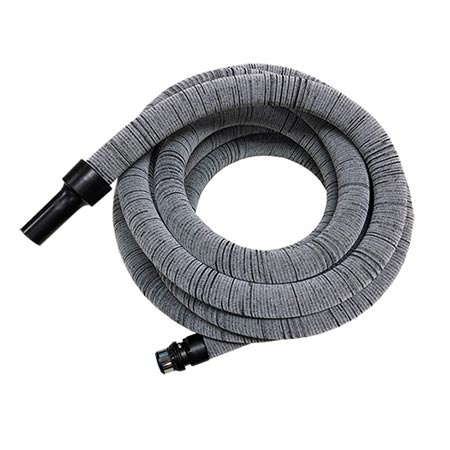My Central Vacuum Hose Needs to Be Replaced. How Do I Figure Out the Correct Replacement?
A central vacuum hose is one of the most important parts of your system, and when it stops working properly, finding the right replacement can feel confusing. With so many connection types, styles, and compatibility factors, it’s easy to worry about ordering the wrong one. The good news: choosing the correct hose is simple once you know what to look for.
This guide explains exactly how to identify the hose you need so you can replace it confidently — and keep your system running at full power.
1. Determine Whether You Have an Electric Hose or a Non-Electric Hose
The fastest way to find the correct replacement is to identify whether your current hose carries electricity to a powerhead.
Electric Hoses
These hoses power an electric carpet brush. They typically have:
- A switch on the handle (usually two or three positions)
- Metal electrical contacts at the wall end
- A corded “pigtail” at the wall end or a “direct-connect” plug built into the cuff
If your powerhead plugs in or is powered through the hose, you need an electric hose.
Non-Electric (Air-Driven) Hoses
These operate suction only. You likely have one if:
- Your carpet tool is a turbine (air-driven) head
- There is no electrical cord at the wall end
- The handle switch only turns suction on/off (if it has a switch at all)
If your system uses an air-driven brush, you need a non-electric hose.
2. Identify Your Wall Inlet Style
Most homes use one of three inlet types, and the inlet determines what hose fits properly.
Standard (Universal) Inlets - The most common style.
- Oval shape with two small metal contacts inside
- Works with most modern central vacuum hoses
Direct-Connect Inlets - Have electrical prongs inside the inlet.
- Used with electric hoses that plug power into the wall automatically
- Usually paired with electric powerheads
Vacuflo-Style / Proprietary Inlets - Slightly different shape
- Often found in older Vacuflo or proprietary systems
- May require a dedicated “style-specific” hose
A quick photo of your inlet usually identifies which type you have.
3. Check Your Handle Style and Tool Compatibility
The handle shape matters, especially if you plan to keep your existing tools.
Button-Lock Handle - The most common
- A round metal button snaps into the wand
- Works with most universal wand sets
Friction-Fit Handle
- No button; the wand slides on and off with friction
- Common on older or basic hoses
Brand-Specific Handles
Some older models (Nutone, Vacuflo, Hayden, Beam, Electrolux) used specialty handles.
If your wand or tools only fit a unique shape, you may need a hose designed specifically for that brand.
4. Decide Between a Standard Hose and a Switch-Controlled Hose
Hoses come in two main control styles:
Basic Hose
- No switch
- Turns on when inserted into the wall
- Great for simple setups or non-electric systems
Switch-Control Hose
- Let’s you turn suction on/off at the handle
- Required for electric powerheads
- More convenient for daily cleaning
If your current hose has a handle switch, you’ll want a switch hose again.
5. Confirm Hose Length and Color (Optional but Helpful)
Hoses are commonly available in:
- 30 ft
- 35 ft
- 40 ft (less common)
If your hose barely reaches certain rooms, now is an ideal time to size up.
Color options vary by manufacturer but are rarely a compatibility issue.
6. When to Replace the Entire Hose Kit
Sometimes replacing the hose alone isn’t the most cost-effective solution.
You may benefit from a full hose-and-tool upgrade if:
- Your powerhead is also aging or discontinued
- Your inlet style is outdated
- Your hose has a non-standard connection
- Your system uses older proprietary fittings
Modern kits often offer better suction flow, better carpet cleaning, and lighter, more flexible hoses.
How Quality Home Systems Can Help
Choosing the correct central vacuum hose is easy when you have expert support. At Quality Home Systems, we specialize in matching hoses to every system — Beam, Nutone, Electrolux, Vacuflo, MD, Hayden, Filtex, Cana-Vac, and more.
If you’re unsure, simply send us:
- A photo of your wall inlet
- A photo of the hose ends (wall end + handle end)
- The brand of your powerhead (if you use one)
We’ll match it quickly and accurately, so you get the right hose the first time.
Final Thoughts
A central vacuum hose can last many years, but once it wears out, replacing it with the correct style is essential for performance and compatibility. By identifying your hose type, inlet style, handle connection, and powerhead needs, you can choose confidently and keep your central vacuum system working at its best.
Quality Home Systems is always here to help guide you through selection, installation, and everything in between.


 Please Wait ...
Please Wait ...
Comments (0)